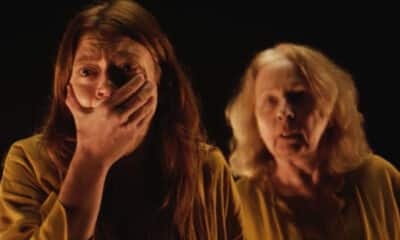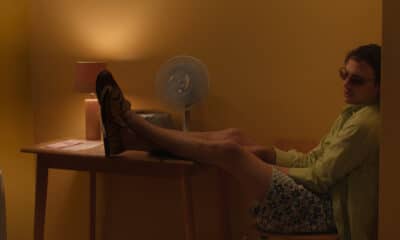When Marnie Was There review: As always, Studio Ghibli provide us with a film for children that adults are more likely to appreciate.

When Marnie Was There review
Over the years Studio Ghibli has given us far too many incredible films. It’s almost unfair when you think about it. So after the retirement of their in house genius, Hayao Miyazaki, the studio announced a period of restructuring and planning where they would discuss the future of the studio. This poorly translated to “We’re done making films, you’ll never see another,” for some reason as people began to fear the worst. Although no such claim was made, many believe that When Marnie Was There could be the studio’s last feature length animated film. Permanent or not, When Marnie Was There offers up a splendid way to end a remarkable era for the studio before they decide how to proceed.
This marks the second adaptation of an English novelist’s work by the director Hiromasa Yonebayashi, who delighted many with his charming adaptation of The Borrowers as Arriety. This time it’s Joan G. Robinson’s book of the same name that is brought to life in ways that only Ghibli can. But it’s not just Ghibli, Yonebayashi has a unique style all of his own, which separates him from the studio and from fellow directors under the banner. There’s a reason his style matches so well with quaint British tales, and that’s because there is a quiet, soulful subtlety that transposes well to Japan. There’s nothing here that panders to the young in the audience. No loud noises, catchy pop tunes, irritatingly boisterous sidekicks. The whole affair feels like a journey out of the city and into the country.

When Marnie Was There review
Anna (Sara Takatsuki), a half foreign foster child with a severe case of asthma, relocates to the country for some much needed rest and fresh air. While there she must confront her own harsh judgements of herself while also exploring the mystery behind the ghostlike Marnie (Kasumi Arimura), a young girl who may be being mistreated in an abandoned mansion on the marsh. It’s quite deep, even for Ghibli standards, but the film avoids complete darkness by focusing more on how these two girls help each other.
The themes explored here are very mature, despite being very relevant to young children. Anna has many confusing opinions of herself, feeling as though she is without a true family, while her foreign blood and blue eyes make her stand out in the Japanese setting. Through a complex friendship we see her experience a girl in a similar but possibly worse off scenario. Marnie puts up a good front, relishing in her parents’ parties, but they are also rarely around, leaving her in the care of an abusive grandmother and less than caring maids.

When Marnie Was There review
Fortunately the art style brings out hope that gradually surfaces. It’s astonishing animation, as you might expect, with every footstep and rustle of leaves has had insurmountable effort put into it. The lighting is also amazing, with sunsets and dark trips across moon reflecting lakes. Even the art within the film is breathtaking, with Anna’s sketches providing a window into how she sees the world.
When Marnie Was There actually puts so much emphasis into the emotion and relationships, that the final reveal and mystery behind Marnie does seem very rushed. It’s all saved for an exposition dump and extensive flashback sequence, narrated by a single character. It’s a lot to take in at the time, and makes the pace suddenly rushed, whereas before it was considered and patient. It’s hard to imagine how else the revelations could have been made, and it by no means ruins the film, just feels a little out of place.
As always, Studio Ghibli provide us with a film for children that adults are more likely to appreciate. It has stunning scenery, perfect vocal casting, a heartwarming and heart wrenching story, with music to set the tone but not tell you how to feel. There’s no doubt that Ghibli will be back, but if it’s a break they want, then When Marnie Was There is a perfect punctuation mark. Like Anna, Ghibli must now find their identity and place in the world without their parents Hayao Miyazaki and Isao Takahata, both of whom are now enjoying retirement. And like Marnie, hopefully Hiromasa Yonebayashi can help lead them in the right direction.
When Marnie Was There review by Luke Ryan Baldock, October, 2015.
When Marnie Was There plays at the BFI London Film Festival on Wednesday 14th October, before being released in the UK by StudioCanal sometime next year.
Luke likes many things, films and penguins being among them. He's loved films since the age of 9, when STARGATE and BATMAN FOREVER changed the landscape of modern cinema as we know it. His love of film extends to all aspects of his life, with trips abroad being planned around film locations and only buying products featured in Will Smith movies. His favourite films include SEVEN SAMURAI, PASSION OF JOAN OF ARC, IN BRUGES, LONE STAR, GODZILLA, and a thousand others.

Latest Posts
-


Film Reviews
/ 11 hours ago‘Fear Street: Prom Queen’ review: Dir. Matt Palmer (2025)
It has been four years since Leigh Janiak’s Fear Street trilogy took horror fans...
By Kat Hughes -


Film Reviews
/ 12 hours ago‘The Surrender’ review: Dir. Julia Max (2025)
As Julia Max’s debut feature, The Surrender, unfolds, the inspirations for the film become...
By Kat Hughes -


Film Trailers
/ 2 days agoFirst trailer for Darren Aronofsky’s ‘Caught Stealing’
Sony Pictures has released the debut trailer for Darren Aronofsky’s new film Caught Stealing,...
By Paul Heath -


Film Reviews
/ 3 days ago‘Lilo and Stitch’ review: Dir. Dean Fleischer Camp (2025)
Director Dean Fleischer Camp won audiences over with the fantastic Marcel the Shell with...
By Kat Hughes

